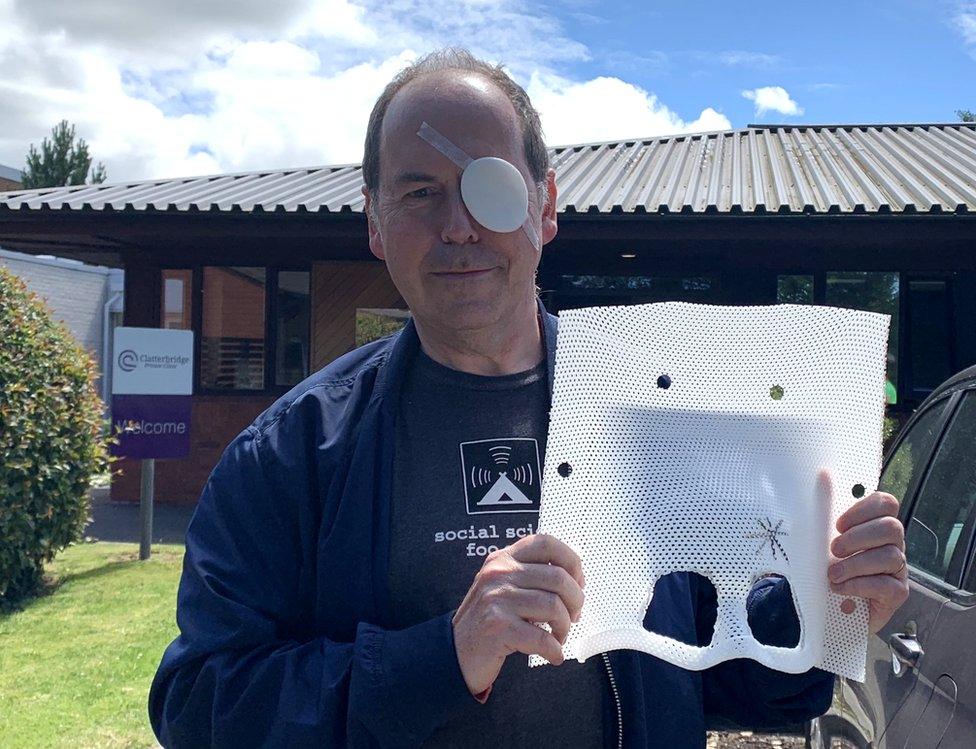Eye cancer: My proton beam therapy diary
- Published
WATCH: Rory's proton therapy diary
I can't say I was looking forward to my course of treatment for an ocular melanoma. A week of radiotherapy does not sound like a holiday.
But the five days I spent earlier this month at the Clatterbridge Cancer Centre in Wirral, proved both fascinating and more positive than I could have expected.
The cancer hospital sprawls over a large site. But tucked away in a small pleasant building at the back is the National Centre for Eye Proton Therapy.
It is the only place in the UK providing this specialised form of treatment for what is a rare cancer.
Every year, about seven out of every million people are diagnosed with a choroidal melanoma.
In the UK, that is about 500 people a year who develop the malignant tumour behind the eye.
There are various forms of treatment for this cancer, including the insertion of a radioactive plaque behind the eye.
That was how I was treated at Moorfields Hospital, in London, in 2005, when I was first diagnosed.
But, increasingly, the merits of proton beam therapy have been recognised.
It involves very precise targeting of the tumour and now nearly half of those diagnosed each year end up being sent to Clatterbridge.

The grey blur at the bottom of this image is Rory's tumour
For me, the process began about a month ago, with an operation under general anaesthetic at Moorfields.
The doctors put markers in my eye for the proton beam team to aim at.
This operation turned out to be the most unpleasant part of the whole process.
Then, a couple of weeks before my treatment, I went to Clatterbridge to have a mask fitted.
A plan was drawn up involving very precise measurements.
Treatment week started with a day of final preparations so that everyone was clear about the exact dimensions of the tumour and the plan to zap it over the following four days.
The centre involves a remarkable collaboration between ophthalmic oncologists, radiographers and nuclear physicists.

The cyclotron
At the heart of it is the cyclotron that produces the protons.
On the Monday - when no beaming was taking place - I was given a tour.
This involved wearing protective clothing and a radiation dosimeter before entering the concrete bunker next door to the treatment room.
Senior physicist Andrzej Kacperek, who has been here since before the centre opened in the late 1980s, was my guide.
He told me that what I was seeing was much like the particle accelerator at Cern, albeit on a smaller scale - a kind of small hadron collider.
"Except it's colliding with your eye," Dr Kacperek said.
The idea behind proton beam therapy is the energy can be targeted so it travels a very precise distance into the body and then stops.
That means it can attack the tumour without damaging surrounding tissue and organs.
So, in the case of eye treatment, it is often possible to avoid causing loss of sight.
On Tuesday, it was the first day of actual beam treatment.
After anaesthetic drops had been put in my eye, I was placed in a highly engineered chair - I'm told it costs several hundred thousand pounds.
My personal mask was fitted and the chair was turned and manoeuvred into position in front of what looked like the end of a telescope.

Rory getting ready for proton beam therapy

Rory in his mask
A few X-rays were taken. Then, as I stared at a red light, a siren went off and the team retired from the treatment room to their mission control, where they monitored my eye on the screens.
Then, there was a new tone and what appeared to be a blue light as the beaming began. It continued for exactly 31 seconds.
Then, the team returned to release me from the mask and the machine - and I was free to go.
Exactly the same routine was repeated on the following three days.
After some trepidation at first, and the mild discomfort of having to sit absolutely still, I quickly found the treatment was painless.
Souvenir
The hugely professional team of radiographers and physicists were wonderfully reassuring, explaining exactly what was going on at each stage. They dealt sympathetically with any anxieties I had.
I was helped by the fact I was filming a video diary of my treatment, with the enthusiastic cooperation of the staff.
Dr Kacperek even wielded the camera at one stage, gathering some vital shots for my video.
The NHS pays for the dozen or so patients who are treated each week to be put up at a local hotel.
We began to recognise each other returning from the hospital, wearing a temporary eye patch until the anaesthetic wore off.

We were a diverse bunch: a builder from Cumbria, an accountant from Glasgow, a retired woman in her 80s from Cheltenham, all affected by this rare condition.
As the week wore on, a camaraderie built up as we compared notes over breakfast and wished each other good luck with the day's appointment with the beam.
On Friday, there was an end-of-term feeling as we headed off for our final appointments.
I emerged from mine with my eye mask as a souvenir, relieved it was over but also strangely exhilarated to have experienced world-class treatment from a team who appear to be at the top of their game.
The next step is to find out how effective it has been.
In late August, I will head to Moorfields Hospital, where the doctors will examine my eye and assess the extent of the damage to my tumour.
- Published12 July 2019

